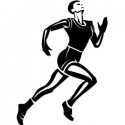By: Alison Hall
Many children dream of becoming professional athletes when they grow up. How many of us wanted to be the next Michael Jordan, Mia Hamm, Derek Jeter, or Serena Williams? While some do get to live their dream, there’s no need for everyone else to give up. For every active NBA player, there are nearly 14,000 athletes ages 35+ playing basketball for fun and fitness (McCall, 2013). Masters athletes are everywhere, and with smart training, they can continue to play for many years to come.
The key to smart training is to create a well-rounded exercise program including cardiorespiratory exercise, resistance training, and flexibility training. Cardiorespiratory exercise continues to be the most popular as athletes age. An ideal training program starts with lower intensity training and progresses toward high-intensity interval training if the athlete is cleared for such activity. While cardiorespiratory exercise remains popular as athletes age, strength training drops off significantly after age 55 (McCall, 2013). Muscle mass decreases at a rate of 10 percent per decade after age 30, so it is suggested that all masters athletes continue strength training. The National Academy of Sports Medicine (NASM) recommends that with a physician’s clearance, masters-age athletes continue strength training 3-5 days per week completing 1-3 sets of 8-20 repetitions at 40-80% of maximum intensity (Clark, Luccett, & Sutton, 2012). Balance should also be included with both strength and flexibility training. Balance training can incorporate exercises such as standing on one foot or by using an unstable surface such as a BOSU balance trainer, stability ball, or balance disc. Flexibility training should include stretching and self-myofacial release, commonly known as foam rolling. Masters athletes may find the combination of these flexibility techniques most beneficial for tighter muscles.
General cardiorespiratory, strength, and flexibility training is great for all exercisers, but what if a masters athlete wants to improve at a specific sport or activity? For example, should a 40-year-old male training for his first 5K train the same way as a 60-year-old female who wants to be able to take care of her grandchildren? Or should the 75-year-old golfer train the same way as the 35-year-old recreational basketball player? Yes, they all should have an ability-specific cardiorespiratory, strength, and flexibility program starting with stability training to achieve a base level of fitness. This base level is the minimum level of fitness an athlete must reach before moving on to more advanced sport-specific training. Once they are ready to progress beyond base level, athletes should train in a way specific for their activity. The runner should train for core stability to improve postural control and body awareness. He needs to build aerobic endurance and leg strength as well. The grandmother needs to focus on core strength and on mobility to pick up her grandchildren and move around with them. She’ll likely need to be able to get down on the floor and have the flexibility to move around and play. The golfer needs to focus on core strength and movement with rotation. He also needs to train for muscle balance so both sides—not just the side he swings from—are equally strong. The basketball player needs to train for endurance and power. His program should include working up toward plyometric training for both jumping and landing safely. He also should include agility training because he will be cutting quickly on the court.
All masters athletes should have a physician’s clearance before training. This important step will help a coach or personal trainer determine intensity, specific exercises to avoid, or other important modifications. In addition, a personal trainer should perform a fitness assessment in conjunction with a physician’s recommendations. After the assessment, a trainer can develop a baseline fitness program and sport-specific programs to keep the masters-age athlete going for life.
Clark MA, Lucett SC, Sutton BG (Eds.) (2012). NASM Essentials of Personal Fitness Training. Baltimore: Lippincott Williams & Wilkins, 396-399.
McCall, P. (2013). Performance training for masters athletes. IDEA Fitness Journal, 10(10), 34-43.

